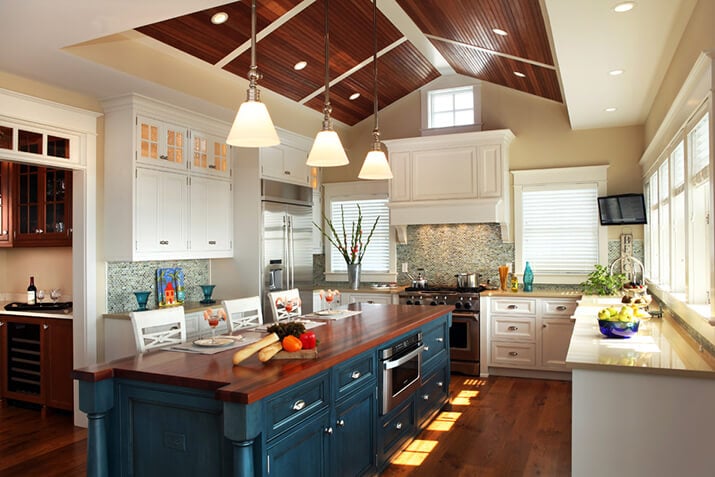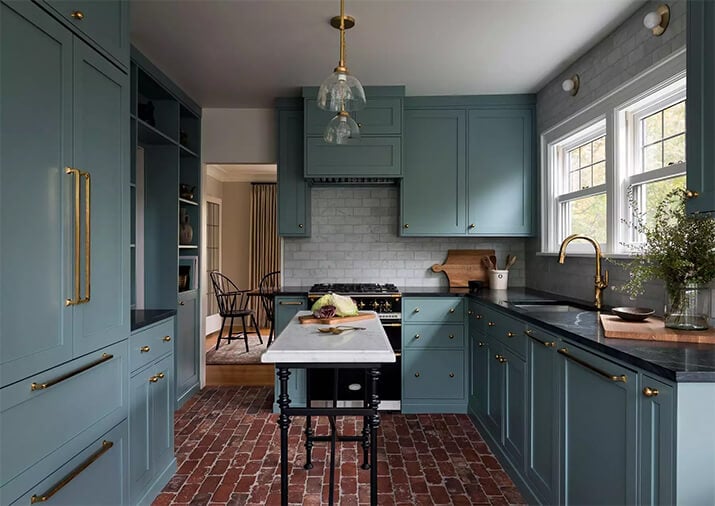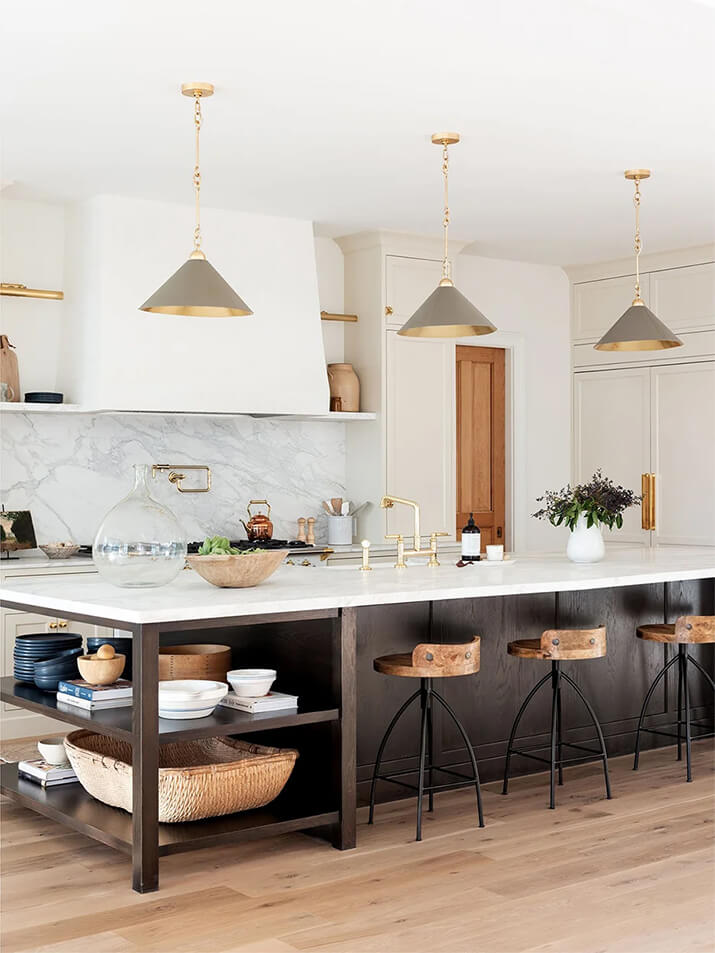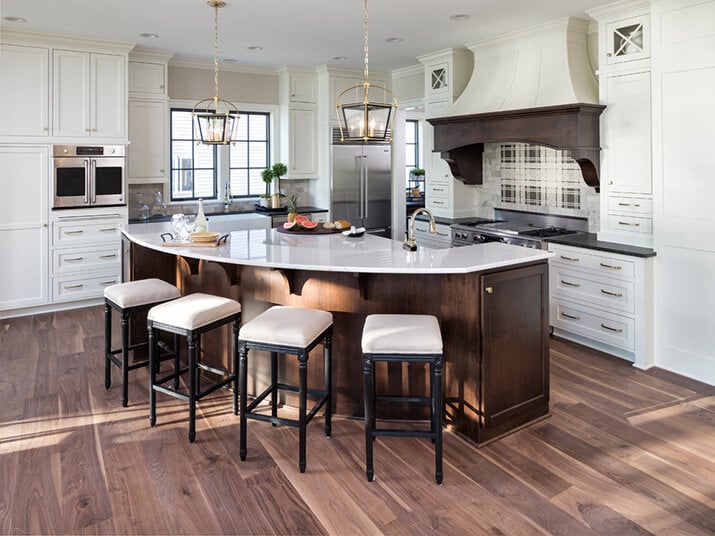Kitchen
How Much Room Is Needed for a Kitchen Island?
Have you ever spent time in someone’s kitchen and found yourself running into each other while cooking? Or maybe you had to rearrange yourself to open the refrigerator successfully. While kitchen islands are a popular kitchen design trend, they don’t necessarily work in every space — especially if you are dealing with limited square footage.
Designing a thoughtful and well-planned kitchen layout ensures your family has ample space for dining, working, and hanging out, without compromising on functionality. If you’re in the process of a kitchen renovation and have been browsing a ton of kitchen island ideas, follow these design tips to help determine if you have enough room in your kitchen.
Determine Your Island’s Clearance Zone

How big of an island are you hoping to install in your kitchen? Before blindly selecting a size and shape, you need to make sure you have ample room to ensure comfort and reduce safety concerns. When possible, it’s best to have at least 42 inches of space between the kitchen countertops and the kitchen island. This allows your family members to move freely within the space. It also ensures that there is enough space to use your kitchen appliances, such as a dishwasher or refrigerator. Consider how far out the doors of these appliances open and make sure there is enough space around them when opened for you to safely move about without falling or tripping.
Accommodate for Small Square Footage

Although the recommended clearance between kitchen counters and the island is 42 inches, you may not be able to meet that if you’re dealing with a small kitchen. The lowest clearance you should ever go is approximately 32 inches of space, but keep in mind that this could still cause issues with opening appliances and unobstructed passageways. If more than one person will be in the kitchen at once, it’s not recommended going smaller than 42 inches of clearance to avoid feeling cramped or causing potential hazards. If you’re set on having an island but don’t have much space, you can opt for a smaller island.
Opt for a Multifunctional Island

What is the purpose of your kitchen island? You need to ask yourself this when determining if you have enough room for an island because different functions may require additional clearance. While you may just be looking for additional counter space, there are plenty of other functions your island can serve. Do you plan to add your cooktop or sink to the island? Are you hoping to add a seating area where your children can work on homework while you cook dinner? Is there a need for another counter space or storage? Create a kitchen island that serves multiple functions with seating, storage, ample counter space, a cooktop, and whatever else you’re envisioning.
Create a Proportional Layout

The size and shape of a kitchen island should be determined by the space you are designing. This means that the larger the kitchen, the more flexibility you have in the size of your island. If you are working with a smaller kitchen, you may have to opt for a smaller island than you initially envisioned. When determining the size and shape of your kitchen island, keep its dimensions proportional to the room to make the layout feel more comfortable and natural.
Frequently Asked Questions
How much space do you need between an island and a counter?
Because there is often a lot of commotion and foot traffic in the kitchen, it’s imperative that it is designed with enough space for all of the people moving about the space. The recommended distance between a kitchen counter and the kitchen island is a minimum of 42 inches. Depending on the square footage of the space, you may opt to increase this to 48 inches (or more!) to fit your needs. For accesibility with wheelchairs, it is recommended that you have at least 60 inches of space between the counters and the kitchen. Having fewer than 42 inches won’t provide enough clearance for you to comfortably work within the space.
Should the cooktop or sink go on the kitchen island?
The best part about designing your own kitchen is that every last detail is determined by you! This means that you can customize every aspect to your own wants and needs. Ultimately, it’s your choice whether or not you think a cooktop or sink on the island makes sense. Keep in mind that having the sink on your island will make any unclean dishes more visible since they won’t be tucked away by the wall. A cooktop on the island can open up the space and allow you to talk to guests sitting at the kitchen island while you cook, but it can also be a danger if you have children who will be sitting there as well. Additionally, you need to factor in the range hood for proper ventilation, which you may or may not like the look of when in the center of your space.
Should I install a prep sink on the island?
Are you considering adding a prep sink to your kitchen? While a second sink isn’t necessary, it’s becoming a popular choice for those who want a separate area for prepping food and cleaning dishes. If you’re thinking about including a prep sink in your kitchen design, the kitchen island is a great place for it. Another recommended location would be by a designated wet bar area. Ultimately, you need to ask yourself if you will use the prep sink for its intended purpose or if you are better off with additional counter space on the kitchen island.
What should I do if my square footage is too small for an island?
Unfortunately, not all kitchens will have enough space for a kitchen island. If your kitchen is less than 13 feet wide, you may want to consider alternative options that won’t make your space feel cramped. Instead, you can opt for a peninsula which still provides additional counter space and storage. Or if you are set on having extra counter space in the middle of the space for easy access, you may want to consider a moving island with smaller dimensions than a standard kitchen island.
![See your dream kitchen in 3D [GET YOUR FREE DESIGN]](https://cdn.kitchencabinetkings.com/blog/wp-content/uploads/see-your-dream-kitchen-in-3d.webp)
![Contractor Discount Program: Offering contractors and builders special volume discounts on all applicable orders [LEARN MORE]](https://cdn.kitchencabinetkings.com/blog/wp-content/uploads/contractor-discount-program.webp)
![Explore our photo gallery [GET INSPIRED]](https://cdn.kitchencabinetkings.com/blog/wp-content/uploads/explore-our-photo-gallery.webp)
![What everyone is saying about KCK [READ REVIEWS]](https://cdn.kitchencabinetkings.com/blog/wp-content/uploads/what-everyone-is-saying-about-kck.webp)
![Get a cabinet sample [SHOP SAMPLES]](https://cdn.kitchencabinetkings.com/blog/wp-content/uploads/get-a-cabinet-sample.webp)
![Pay over time, on your terms with Affirm [LEARN MORE]](https://cdn.kitchencabinetkings.com/blog/wp-content/uploads/pay-over-time-on-your-terms-with-affirm.webp)